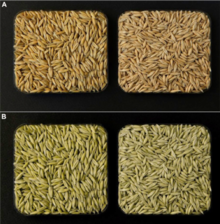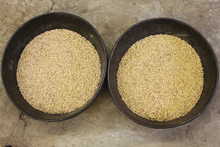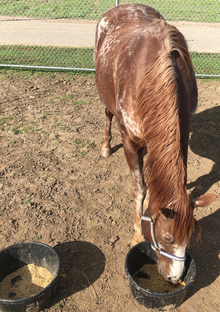Quick facts
- People who sell oats believe that horses and their owners prefer white-hulled oats.
- In this study, horse owners didn't show a preference for either yellow- or white-hulled oats.
- Horses preferred yellow-hulled oats over white-hulled oats.
- When choosing oats, horse owners are most concerned with cleanliness, not color.
- Owner and horse preference for white-hulled oats weren't validated.
Horse owners have been feeding oats to their horses for centuries. Oats are palatable, easy to digest and have good nutritional value.
Oats have an outer covering, or hull, that protects the grain from insect damage and disease. Modern oat varieties vary in hull color, ranging from white to yellow to tan, and even black. While hull color hasn't been found to make a difference in grain nutrition, horses are usually fed white-hulled oats because grain marketers believe horses and their owners prefer them.
We conducted a horse intake trial to determine if horses do in fact have a preference for a particular hull color. We also surveyed horse owners and managers to see if they have a preference.
Testing for oat preference in horses
We used six adult, stock-type horses to test horse preference between white- and yellow-hulled oats.
- Horses had not previously eaten oats but were acclimated to them for three days prior to the trial.
- Horses were offered oats after eight hours of grazing and before being fed a ration balancer meal each day.
- Each day, horses were led into individual stalls with their dry lot and were given a feed pan containing white-hulled oats and a feed pan containing yellow-hulled oats.
- Horse selection and behavior (eating/chewing vs. walking around) was recorded every 15 seconds for five minutes.
- Oats were weighted before and after to determine amount consumed (an indicator of preference).
Consumer oat preference survey
- We administered a survey on oat use among horse owners and managers to determine if they preferred one hull color over another.
- The survey was available for eight weeks (February 6 to March 20, 2017) and advertised via the UMN Equine Extension Facebook page and newsletter.
- The survey focused on oat preferences, other horse feed and owner and manager demographics.
Horse preference trial
Overall, horses preferred yellow oats.
Individually, horses 1 and 4 didn't display a preference, whereas all other horses preferred yellow-hulled oats.
On average, horses spent 3 out of 5 minutes eating yellow-hulled oats and 2 out of 5 minutes eating white-hulled oats. As a whole, horses went to the pan containing yellow-hulled oats first 74 times and went to the pan containing white-hulled oats first 70 times.
Average amount of oats consumed in a 5-minute period and number of times each oat hull color was selected first for consumption.
| Horse | Yellow oats eaten (lbs.) in 5 minutes | White oats eaten (lbs.) in 5 minutes | #Times Yellow chosen first | #Times White chosen first |
|---|---|---|---|---|
| 1 | 0.98 | 0.88 | 15 | 9 |
| 2 | 1.31 | 0.32 | 8 | 16 |
| 3 | 1.04 | 0.60 | 14 | 10 |
| 4 | 0.72 | 0.84 | 12 | 12 |
| 5 | 0.88 | 0.50 | 13 | 11 |
| 6 | 0.97 | 0.53 | 12 | 12 |
| Average | 0.98 | 0.61 | 12.33 | 11.66 |
Owner and manager survey results
- 801 equine owners and managers responded to the online survey.
- 86 percent were women between the ages of 41 and 60 years old (35 percent).
- 86 percent resided in the Midwest.
When represented with images of both white hulled and yellow-hulled oats, individual preference was split.
- 27 percent preferred white-hulled oats.
- 36 percent preferred yellow-hulled oats.
- 31 percent had no preference.
We asked owners and managers to rank the most important (1) to least important (6) qualities they consider when choosing oats.
- Cleanliness (free of contaminants; average rank = 1.79)
- Availability (3.12)
- Cost (3.21)
- Protein content (3.46)
- Color (4.04)
- Test weight (4.79)
291 respondents indicated no preference when choosing oats.
Of factors surveyed for buyer's preference, only gender, the length of time individuals owned or managed horses, and if they fed oats, directly affected a preference between the oat hull colors. The decision to feed oats was driven by where the oats were purchased (close to home) and in what form (in a feed mix or as the sole grain).
Reviewed in 2024




